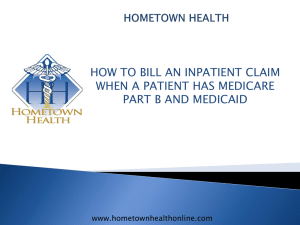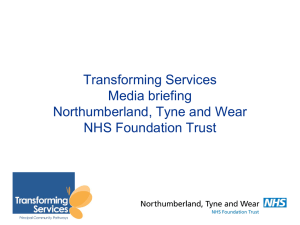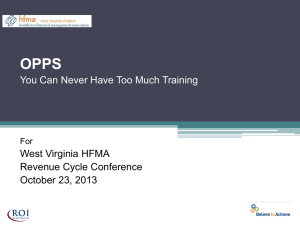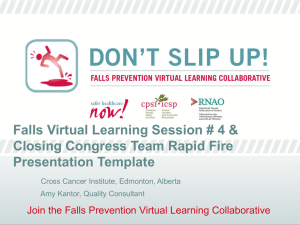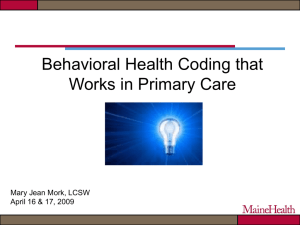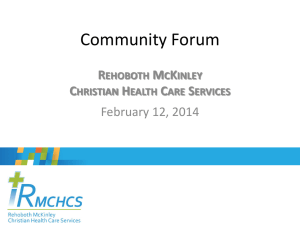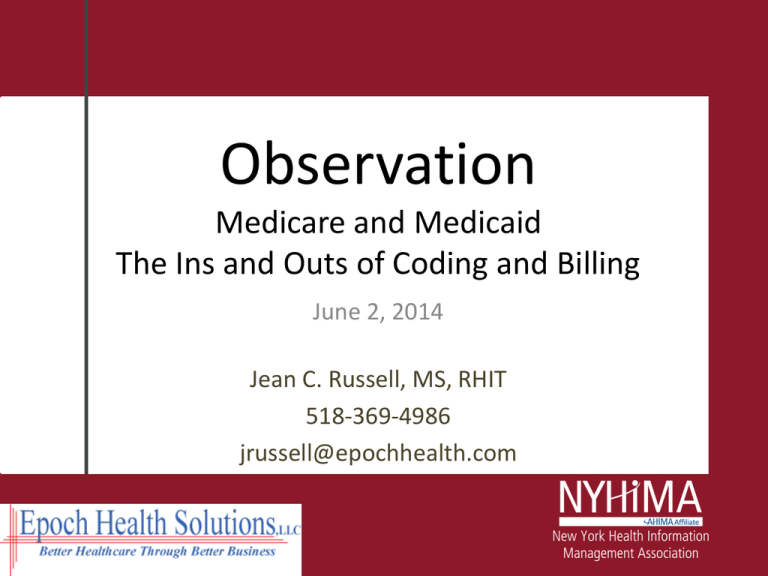
Observation
Medicare and Medicaid
The Ins and Outs of Coding and Billing
June 2, 2014
Jean C. Russell, MS, RHIT
518-369-4986
jrussell@epochhealth.com
Agenda
•
•
•
•
•
Background
NY Medicaid Observation
Medicare – IPPS 2014 Final Rule
Rebilling Denied Part A as Part B
Medicare – Current Billing Requirements
for Observation
• Medicare – OPPS 2014 Changes
• Questions / Discussion
2
Background
Level of Care
• Outpatient Status
– Outpatient care
• For example – Clinic, Emergency department, Outpatient
surgery Extended surgical recovery over-night
– Observation service
– Medicare Part B
– Paid on APCs (Medicare) and APGs (Medicaid)
• Inpatient Status
– Medicare Part A
– Paid on MS-DRGs (Medicare) and APR-DRGs
(Medicaid)
Medicare
Observation Vs. Inpatient Stay
• Observation is Part B, Inpatient is Part A
– Part A has a single deductible (co-pay) for a hospital stay
– Part A covers most of the cost of the stay
• Part B has individual co-pays for each of the
procedures performed (e.g., x-rays, MRIs, ED visit,
drug administrations)
– The cap on each individual co-pay is set at the Medicare
inpatient cap
• But the sum of the co-pays can be significant
• Cost to patient may well be higher as observation
Medicare
Observation Vs. Inpatient Stay
• Certain services covered in a Part A visit
are not covered under Part B
– E.g., self-administered drugs
– Services that did not meet medical
necessity (e.g., radiology)
• SNF coverage under Medicare requires a
medically necessary 3 day admission
prior to the SNF
Observation Cases Increasing
• According to a recent article:
– The use of observation status has nearly doubled in the past
six years
– Observation stays of more than 48 hours have increased from
3% to 8%
– Number of patients in the hospital for at least three days that
could not qualify for SNF due to observation was over 600,000
last year alone
• Shorter stay inpatients cases are closely scrutinized
• Sometimes observation is a fallback to ensure the visit
will be covered
Source: http://www.npr.org/blogs/health/2013/09/04/218633011/for-hospital-patients-observation-status-can-prove-costly
Short Stay Inpatient
Admission Reviews
• Increasing scrutiny by private payers and auditors
• Target of Office Inspector General (OIG) and Office of
Medicaid Inspector General (OMIG) audit plans
• Focus of Medicare’s PEPPER
• Reviewed by Medicaid Integrity Contractors (MIC) and
Medicare Recovery Auditors
• Reviewed by the Medicare Administrator Contractor
(MAC) – NGS for New York
• And now subject to the Two Midnight Rule
NY Medicaid
Observation Coding, Billing
and Payment
9
NY Medicaid and Observation
• Effective April 1, 2011
– Medicaid began coverage of
emergency room observation services
– However, the requirements for billing
for the service were strict, including:
• Waiver requirement
• Distinct observation unit
NY State Medicare Update, May 2011,
http://www.health.ny.gov/health_care/medicaid/program/update/2011/m
ay2011mu.pdf
April 2011 Requirements
• Observation Waiver Requirements:
– Distinct physical space (not scatter bed
model)
– Unit can only be used for observation
– Patients should require 8-24 hours of care
– Overseen by the ER
– Patients must come through the ER
NY State Medicare Update, May 2011,
http://www.health.ny.gov/health_care/medicaid/program/update/2011/may2
011mu.pdf
February 2012 Changes
• Effective January 11, 2012, observation units
had to be established in compliance with Title
10, Section 405.19, rather than through a
waiver
• Hospitals that previously provided services
under the waiver had 24 months of the
effective date of the regulation change (i.e.,
January 11, 2014) to be in compliance with the
regulations
NY State Medicare Update, February 2012,
http://www.health.ny.gov/health_care/medicaid/program/update/2012/201202.htm#health
Changes Effective April 1, 2013
• Impacts NY Medicaid, including FFS, Medicaid
Managed Care and Family Health Plus
• Expanded coverage of Observation Services
• Observation services are designed for patients for that
cannot be treated and released in the ED, but should
reasonably be expected to be discharged within 48
hours
• A patient must be in observation at least eight hours
(with clinical justification)
• This is in addition to time spent in the ED prior to
receiving observation services
April 2013 Changes
• Observation services may now be provided in:
– An approved unit that has an existing waiver
– An existing observation unit in compliance with 10
NYCRR 405.19
– New distinct observation unit in compliance with
10 NYCRR 405.19
– Inpatient bed (i.e., “scatter bed”)
– The ED (for CAH or sole community hospitals)
• Observation services may be provided up to
48 hours, after which the patient should be
admitted or transferred or discharged
April 2013 Changes
• Required documentation for Medicaid
payment for observation includes:
– A clinical justification for observation
status
– A working diagnosis
– Tests/treatments administered
– Progress notes by physician or mid-level,
and
– Final disposition of the patient
April 2013 Changes
• Must be assigned from the ED or hospital OP
department if the facility does not have an ED
• Service is billed with HCPCS code G0378, hospital
observation per hour
• Groups to APG 450
• Units reported should be number of hours, up to 48
• Will only be reimbursed if units exceed 8 (that is 8 to
48 hours)
– Should still be reported even if less than 8
April 2013 Changes
• Observation ends when patient is either
discharged or admitted
• If patient is admitted, only the inpatient
claim should be submitted for payment
– Charges from the outpatient part of the
visit are included on the inpatient claim
• If the patient is transferred, the ED and
observation services may be submitted
for payment
April 2013 Changes
• Time away from observation should be
excluded from the observation time
Significant procedures such as MRI, PET
and CT scans will result in G0378 being
packaged (i.e., not paid)
• Low level ancillaries will allow
observation to be paid separately
April 2013 Changes
• Discrete observation unit established in compliance
with 10 NYCR 405.19 reported with the UC modifier –
reimbursed at an enhanced rate (20% higher)
• Scatter bed services reported without the UC modifier
• Order for observation must be clear and must clearly
identify observation as outpatient
• Patient must be advised that they are outpatient and
the stay does not meet Medicare inpatient
requirements for SNF services
Source: May 2013 Medicaid Update,
http://www.health.ny.gov/health_care/medicaid/program/update/2013/201305.htm#osl
3M EAPG
October 2013 Changes
•
•
•
•
APGs 500-502 are new in 2013
APG 492 is EAPG Type Incidental
APG 450 is EAPG Type Ancillary
APGs 500-5012 are EAPG Types Medical
APG Logic for New
Observation APGs
• G0378 maps to APG 450
• G0379 and other observation CPTs
map to APG 492
Ancillary Observation –
APG 450
• Billed with G0378, Hospital observation service, per hour
– Paid with units >= 8, should be <= 48
– UC modifier if discrete unit
• Typical rate code 1402, Emergency department
• Must have a medical visit (e.g., 99285)
• Groups to APG 450, Observation
– Relative Weight = 0.1563 (down from 2.1949, but now is
per hour)
– Payment $24 (upstate) to $31 (downstate) per hour
– Paid in addition to ED visit, packaged with significant
procedures
Medical Observation –
APGs 500, 501, 502
• Medical observation APG assignment
– Must be reported:
• A CPT or HCPCS code assigned to APG 492 (e.g., G0379)
• Plus G0378 which is assigned to ancillary observation APG 450
– EAPG 492 changes to one of three medical EAPGs
(if all criteria met)
• 500 ENCOUNTER/REFERRAL FOR OBSERVATION - OBSTETRICAL
• 501 ENCOUNTER/REFERRAL FOR OBSERVATION - OTHER DIAGNOSES
• 502 ENCOUNTER/REFERRAL FOR OBSERVATION - BEHAVIORAL HEALTH
– Final medical observation APG assignment is
determined by primary dx code
• APG 450 is packaged
• Observation is packaged if a significant procedure is
reported, e.g., 59025 – Fetal Stress Test
Medicare
IPPS Final Rule Changes
Effective 10/1/2013
24
Inpatient Versus Observation
• Order - Inpatient order must be clear “admit
to inpatient” or “admit as an inpatient” –
cannot be vague such as “admit to C5”
– The word “admit” alone is not sufficient
• Length of Stay - Presumed to be medically
necessary if the stay crossed two midnights for
“medically necessary services”
– Order must document the expectation
– Less than two midnights would be
presumed to not meet inpatient criteria
Medical Review Policies
• Two midnight benchmark
– Begins when the patient starts
hospital care (i.e., comes into the ED)
• Two midnight presumption
– Presumed to meet medical necessity
if the stay was at least two midnights
• Reviews will focus on inpatients with
stays less than two midnights
Physician Certification
• Physician certification required
– Authentication of the order to admit
– Provides the reason for the inpatient services
– Estimates the time the patient will need to be in
the hospital and
– The plans for post-hospital care
• The physician certification must be completed,
signed, and dated and in the medical record
prior to discharge
• A specific format is not required
Recent Clarifications
• For patients transferred in, the receiving hospital can
take into account the time spent at the transferring
hospital when determining whether the patient met
the 2-midnight benchmark
• Off-campus ED’s are still considered part of the
hospital and time spent in these departments would
count into the 2-midnight calculation
• CMS has requested re-reviews of denials made during
the probe audit to ensure they are consistent with
these clarifications
Source: http://www.cms.gov/Research-Statistics-Data-and-Systems/MonitoringPrograms/Medicare-FFS-Compliance-Programs/Medical-Review/InpatientHospitalReviews.html
Rebilling Opportunities
• When an inpatient stay has been deemed not
medically necessary after the beneficiary has
been discharged
– Could be due to a RAC denial, a MAC denial, a
prepayment review, or the provider review itself
• Bill all services up to the inpatient order as
Part B OPPS (bill type 13x)
• Bill all services after the inpatient order as
Inpatient Part B (bill type 12x)
Source: NGS website release 5/7/2012
http://www.ngsmedicare.com/wps/portal/ngsmedicare/!ut/p/c4/VU27DsIwDPwWhsxJoRMbdIClHSgSj800pli0cZW65fdJUjEg
Sz77znfWdx3KwUwtCLGDTl_17dP02wHkpbINKFMd6hItNeCxYCfo5I9T5oQjT77BUZkzczeqbG3A2QglCHqCwJmiA0_PYIl_
orb0enr0JEKujVs4oj4FXF6Y9PDS0s9SsMWIeZ42Tyk9zkeYk1KxRNjj4i5R9PDerb6jtAtv/
Medicare Timely Filing
• Subject to the Timely Filing Rule
• Medicare defines the timely filing period as no later
than 12 months after the date of service
• Inpatient claims denied later than this are past the
timely filing limit and cannot be corrected and rebilled
• Unfortunately, many times auditor denials are after
the timely filing, in which case the Hospital has no
option for recouping payment
• Changes the March 13, 2013 CMS ruling
Chapter 1, Medicare Claims Processing Manual, Section 70 – Time Limits
for Filing Part A and Part B Claims
Rebilling Steps
IP Claim Cancelled
• Bill type 110
• ICD-9 Dx Codes
• And Procedures
OP Claim
IP Part B
• Bill type 121
• Post IP Order
• CPT
Procedures
• Bill type 13x
• CPT Pre IP
Order
Procedures
• Steps to follow:
1. Submit an inpatient no-payment claim for the
inpatient stay using bill type 110
2. Submit an inpatient Part B claim for the billable
services that occurred during the inpatient stay using
bill type 12X
–
–
That is an Inpatient Part B claim for services provided after
the inpatient admit order
Final rule expanded this to include just about all services
except services that have to be outpatient such as medical
visit services (ED /Observation /G0379), diabetic self
management training (DSMT)
IP Claim Cancelled
Clarification
• Bill type 110
• ICD-9 Dx and
Procedures
IP Part B
• Bill type 121
• Post IP Order
• CPT
Procedures
OP Claim
• Bill type 13x
• CPT Pre IP
Order
Procedures
3. Submit an outpatient claim(s) for the outpatient
preadmission services that occurred prior to the
non-covered inpatient stay using bill type 13X
–
–
–
Based on the fact that the submission of outpatient
preadmission services is permitted when there is no Part A
payment made for the inpatient stay
That is, the outpatient services are not bound by the 72
hour rule
Would include the ED or clinic visit that occurred prior to
the order to admit
Source: http://www.cms.gov/Outreach-and-Education/Medicare-Learning-NetworkMLN/MLNMattersArticles/downloads/MM7672.pdf and
http://www.medicarenhic.com/pa/billing/ConditionCode44.pdf
The Beneficiary
• Beneficiaries are entitled to receive information about
coinsurance and deductibles
• Inform beneficiaries in writing that the inpatient stay
is not going to be billed to Medicare as a covered
claim and why
• Beneficiary may be responsible for coinsurance (for
the 12X bill and for the 13X bill) instead of an inpatient
deductible
• If the inpatient deductible has already been paid, it is
the responsibility of the provider to make a refund as
appropriate
Rebilling for Denied Part A
• Chapter 3 of the Medicare Claims
Processing Manual states that hospitals
have to bundle most outpatient services
performed within 72 hours of an
inpatient stay “when Part A payment can
be made on the inpatient stay”
• But this does not apply when no Part A
payment can be made on the inpatient
claim
Source: http://www.cms.gov/Outreach-and-Education/Medicare-Learning-NetworkMLN/MLNMattersArticles/downloads/MM7672.pdf
Inpatient Part B Expansion
• Expansion of services that can be billed now includes
most services, even PT/OT/ST
• Does not apply for other circumstances when there is
no Part A payment such as when Part A benefits have
been exhausted
• Does not include observation since unless there is an
order for observation prior to the order for inpatient
(in which case it would be billed on the 13x bill)
• List of rev codes not covered, see MLN Matters
SE1333, http://www.cms.gov/Outreach-and-Education/Medicare-Learning-NetworkMLN/MLNMattersArticles/downloads/SE1333.pdf
Condition Code 44 Order
Inpatient
Observation
• Must occur Prior to Discharge
– CM / UR physician advisor / Attending physician all involved in
decision
– Should be relatively rare
– Requires signature of both UR and Attending physicians
• Must notify the patient (signed document suggested)
what it means to be an observation case
• Observation time starts with the observation order
change
– Often not w/ the required 8 hours
• Result is a bill type 131 outpatient claim
Current Medicare
Rules
Observation Coding, Billing and
Payment
37
Observation is a Timed Service
• Reported by the hour – rounded to the nearest hour
• Starts: physician order time and date and observation treatment has
started
– Clear order to admit as inpatient Vs. refer to observation
– Nursing documentation indicating observation care has started
• Ends: physician order time and date to discharge from observation
or hospital and medical treatment has ended
– Note that “discharge after consult” or other critical, but delayed
medical test should be clearly documented
– “Waiting for a ride” is not considered part of observation time
Chapter 4, Medicare Claims Processing Manual,
http://www.cms.gov/Regulations-andGuidance/Guidance/Manuals/Downloads/clm104c04.pdf
Observation is a Timed Service
• Does not include time that is:
– Concurrent with diagnostic testing or
therapeutic services that includes
active monitoring, “(e.g., colonoscopy,
chemotherapy)”, or
– Services that are part of another
service (e.g., PACU)
• Need to implement a system to extract
other procedural time from observation
hours
Reporting Observation
• If a period of observation spans more than
one (1) calendar day, all of the hours for the
entire period of observation must be included
on a single line and the date of service for that
line is the date that observation care begins
Source, Medicare Claims Processing Manual, Chapter 4 http://www.cms.gov/Regulations-andGuidance/Guidance/Manuals/Downloads/clm104c04.pdf
Reporting Infusions
“Drug administration services are to be reported
with a line item date of service on the day they
are provided. In addition, only one initial drug
administration service is to be reported per
vascular access site per encounter, including
during an encounter where observation services
span more than 1 calendar day.”
Source, CMS Medicare Claims Processing Manual, Chapter 4, Section 230.2,
http://www.cms.gov/Regulations-andGuidance/Guidance/Manuals/Downloads/clm104c04.pdf
Reporting Observation
• Medicare reporting
– Revenue code 762, observation
– G0378, Hospital observation service, per
hour
– Units - The number of hours
• Time must be calculated
• Suggest a documentation review required to
ensure accurate reporting of units
• If calculated automatically, perform an internal
audit on at least a select number of cases
Observation Coverage
•
•
Should not be billed for monitoring and care
during standard postoperative recovery
period (e.g., 4-6 hrs)
Can be billed for complications requiring
extended post-surgical recovery care
• But will not be reimbursed for the
composite rate when there is a surgery
prior to the observation
• Needs to be ordered
43
Observation Payment
• Extended Assessment and Management
composite payment that covers an episode of
care involving more intense assessment and
management, includes:
– A high-level clinic or ED visit, direct referral to
observation, or critical care service
– 8 hours or more of observation services
– Other associated services (packaged)
Observation Changes for 2014
• Significant increase in packaged services
(e.g., lab and stress tests)
• Reduction of clinic E/M codes to a single
G code (G0463)
• Required changes to observation
composites
Extended Assessment and
Management Composite (EAM)
• In 2013 there were two composite EAMs
– 8002 and 8003
Level I Extended Assessment and
Management - APC 8002
• G0378 (8 or more units)
• Revenue code 762 (observation)
• Reported with:
– G0379 (direct referral) on the same date of service, or
– 99205 / 99215 (level V clinic visit) on the same date or day
before
• Reported without a surgical (Status T) procedure on the same day
or day before
• National APC Rate (2013) = $440.70
• No diagnosis requirement
Level II Extended Assessment and
Management APC 8003
• G0378 (8 or more units)
• Revenue code 762 (observation)
• Reported with:
–
–
–
–
99284 / 99285 (high-level ED visit), or
High Level E/M
99291 (critical care), or
G0384 (high level Type B ED visit)
On the same day or day before the observation
• Reported without a surgical (Status T) procedure on
the same day or day before
•
National APC Rate (2013) = $798.47
• No diagnosis requirement
Extended Assessment and
Management Composite (EAM)
• Effective 1/1/2014 there will be only one composite
EAM – 8009
– G0378 (8 or more units), revenue code 762
(observation) with no diagnosis requirement
– Reported with an E/M service:
• 99284 / 99285 (high-level ED visit) 99291 (critical care)
• G0384 (high level Type B ED visit)G0463 (clinic E/M)
• Or G0379 (direct referral to observation from physician
ofc)
• On the same day or day before the observation
– Reported without a surgical (Status T) procedure
on the same day or day before
– National APC Rate (2014) = $1,198.91
Observation Payment
G0379 – Direct Referal
• G0379 – Direct referral to observation, moved
to APC 608, payment increased to $327.85
(2014) from $175.79 (2013)
– 2012 - reimbursed as a 99211 (APC 604)
– 2013 - reimbursed as a 99205 – new patient clinic
level V
– 2014 – reimbursed between a level IV and V ED
E/M
• Paid only when observation is not paid
• Improved reflection of the cost associated
with direct referrals to observation
What this means to Medicare
Observation
• Increased composite reimbursement
• Extensive bundling of services
• Add-ons, ancillaries, lab and drugs not
separately paid
• Composite payment increases, but
packaging of services increases as well
Summary
• Observation is payable by both Medicare
and Medicaid as an outpatient service
• Impacts reimbursement for hospital and
cost for patients
• There are specific requirements that
must be met to bill observation correctly
• Significant changes started in October
• More changes were made in January
Questions/Discussion
55
Contact Us
Richard Cooley
Phone: 518-430-1144
Email: rcooley@epochhealth.com
Matthew Lawney
Phone: 845-642-6462
Email: mlawney@epochhealth.com
Jean Russell
Phone: 518-369-4986
Email: jrussell@epochhealth.com
http://www.EpochHealth.com/
57
CPT®
Current Procedural Terminology (CPT®)
Copyright 2013 American Medical
Association
All Rights Reserved
Registered trademark of the AMA
58
58
Disclaimer
Information and opinions included in this
presentation are provided based on our
interpretation of current available
regulatory resources. No representation is
made as to the completeness or accuracy
of the information. Please refer to your
payer or specific regulatory guidelines as
necessary.
59

